Theory of National Struggle
The Theory of National Struggle (simplified Chinese: 民族斗争理论; traditional Chinese: 民族鬥爭理論; pinyin: Mínzú Dòuzhēng Lilùn), or Ethnic Struggle, is one of Mao Zedong's political theories on the application of Marxism in China. This theory is also Mao Zedong's remedy to the "National Question" in Marxist theory. As a subset of the general philosophy of Mao Zedong Thought (Maoism), the theory of national struggle addresses the question of how classical Marxist-Leninist ideas of political economy should intersect with China's particular need for constructing a multi-ethnic national sovereignty without abandoning the universality of Marxism-Leninism. The gist of Mao's theory is that Chinese communists should treat the question of national and ethnic liberation in China as a subset of the larger socialist project of class conflict.[1] In strategic terms, this means that the key to constructing a multiethnic Chinese nation-state is to mobilize and transform "backward" ethnic minorities into modern subjects of proletariat class consciousness under the leadership of the Chinese Communist Party (CCP).[2]
| Part of a series on |
| Maoism |
|---|
 |
|
People
|
|
Theoretical works |
|
History
|
|
Related topics |
|
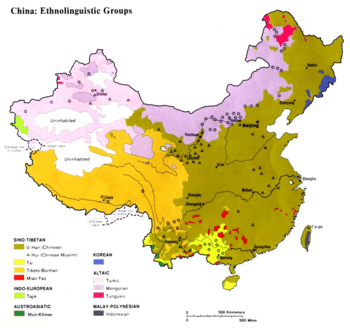
Mao's political theory of "Nation Struggle" works in tandem with his theory of history, "New Democracy".[3] In formulating the history of Modern China as a series of social, political, economic, and cultural transformations marked by a national process of class awakening reacting against encroachments by Western and Japanese colonial aggressions, Mao argued that a "national struggle" to restore Chinese sovereignty was the first vital step in constructing a multi-ethnic regime of proletariat dictatorship.[4] In doing so, Mao prioritized the creation of a united front against foreign aggressions as the larger struggle of the Chinese Revolution, one that involves the simultaneous cultivation of a united national identity amongst different ethnic minority groups and the transformation of "feudal-minded" ethnic minority populations into modern proletariat subjects.[5]
The amalgamation of Mao's two separate theories of revolution signified his theoretical departure from the general doctrine of Marxism-Leninism in Soviet Union and in Europe, which strictly held the economic-determinist ideal that base determines superstructure.[6] Mao's theories not only addressed the primacy of nationalism in revolutionary mobilization, but also cast doubts on the classical Marxist notion of historical inevitability because Mao argued that a nationwide class consciousness could not be awaken in China unless cultivated by party leadership.[7] Moreover, by conflating the notions of "ethnicity" and "nationality," Mao justified the CCP's geopolitical claim over the former territories and ethnic minority subjects of the multi-ethnic Qing Empire.[8] Since Mao came to power in the communist establishment during the Yan'an period, Mao's theory of "national struggle" became the guiding principle of ethnic and national liberation strategy of the Chinese Communist Party until his death in 1976.
Background
Origins
The National Question
One of the greatest theoretical conundrums in Marxism was the contradiction between internationalism and nationalism, the theory and praxis of proletarian revolution.[9] In the original Das Kapital, Marx offered neither a systematic theory of the national question, a precise definition of the construct of the "nation," nor a general political strategy for the proletariat to seize state power. Even when Marx did talk about the political implications of the worker's state that he envisioned, his articles on the subject were, for the most part, strictly analytical and rooted in the concrete political cases derived from his historical observations.[10] Due to the ambivalence on statecraft in Marxist theory, Marxist theorists and revolutionaries from different regions and eras generally reinterpreted Marx in order to accommodate local demands for national sovereignty under pressure of global capitalist intervention. In 1920, Lenin theorized that the creation of a national community must start with the unification of the oppressed races and ethnicities to create a worker's state, against the oppressive races and ethnicities of imperialism.[11] In this process of unification, Lenin argued that the proletariat must lead the revolution by breaking through boundaries of geo-cultural of difference to reach people who were less enlightened, with the ultimate goal of creating a communist society under universal proletariat leadership.[12] Lenin's approach to the classical "National Question" in 1920 also included a specific political strategy of liberation with regards to minority ethnicities, in which Lenin claimed that the oppressed races and ethnicities should reserve the right of ethnic-self determination once a universal worker's state is established.[13] In addition, Lenin argued that the principle of ethnic self-determination could prevent the proletariat from being corrupted by capitalist chauvinists, who would harness cultural difference and nationalism as a tool to divide the oppressed.[14] In the later years of Soviet Union, Joseph Stalin would co-opt Lenin's approach to the "National Question" to advance and legitimize his own theory of "socialism in one state."
A devout critic of Stalin's "socialism in one state" theory, Leon Trotsky approached the "National Question" by combining Lenin's theory of "unified and uneven development" with his own insights on Marx's concept of "permanent revolution." Trotsky saw the Great War in Europe as a product of the contradiction between the productive forces and the restrictive framework of the nation-state, and he argued for the ultimate destruction of the nation-state system altogether once global communism was accomplished.[15] He deemed the "National Question" as a temporary political form that would eventually diminish through the dialectics of historical development. Under Trotsky, Lenin's theory expanded into a revolutionary strategy which argued that backward countries do not need to pass through the same sequential stages of linear development already achieved by advanced societies.[16] Instead, Trotsky argued that backwards societies and ethnic groups could "skip stages" of development by having the industrial proletariats from core nations lead the revolution and develop on their behalf. In doing so, Trotsky argued that the global proletariat could permanently prevent a capitalist restoration, advancing an internationalist vision of "unequal but simultaneous revolution" which fundamentally rejected Stalin's ideological premises.
In East Asia, theoretical approaches to the "National Question" were generally centered around the notions of ethnic development and national identity, since intellectuals in China and Japan constantly sought to redefine what it meant to be "modern" when their traditional cultural subjectivities were threatened, subverted, and dismembered by the colonial "west" in the wake of global capitalist intervention. Political scientist Germaine Hoston has recently written about the modification and reception of the "National Question" as it was transported from Europe and Soviet Union to East Asia by the Comintern. She argues that in Japan and China, the significance of the national question expanded beyond the narrow focus of "nationality" in European Marxism (namely the attempt by ethnically distinct populations to construct their own national communities in the wake of rising transnational class consciousness) to include issues such as ethnic development, modernization, statecraft, cultural identity, and human agency.[17] Thus, rather than simply being a political question of how to create a worker's state in latecomer societies, the "National Question" in East Asia evolved into a systematic power discourse which legitimized the absorption of culturally distinct minorities into the nascent multi-ethnic polity of nation-building regimes like the PRC. In China, this metamorphism was generally lead by the CCP under the leadership of Mao Zedong, although other important theorists also participated in the engineering of the theory of "National Struggle."
History
Despite the canonization of Maoism in the People's Republic of China, Mao's theory of "national struggle" was not a monolithic construct that was unaffected by the vicissitudes of time. Neither was Mao the only contributor to China's unique Marxist political theory of ethnic liberation.[18] Historically, Mao's political theory of "National Struggle" went through several stages of rhetorical and strategic development under the Long March, the Yan'an Rectification Movement, the Second Sino-Japanese War, the Chinese Civil War, and the People's Republic of China. Contemporary scholars of Mao Zedong Thought in the North American academia generally avoid periodizing the history of Maoist philosophy into strict categories of linear development. In the Chinese academia, however, the periodization and categorization of Mao Zedong Thought is encouraged by the state because it helps to establish Mao's theories as ideological doctrine. In general, Chinese scholars identify four to five developmental stages of Mao's National Struggle Theory.[19]
Early development: 1919–1934
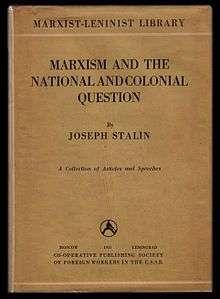
The First phase is the Inchoate Experimental Phase (May 1919 – October 1934).[20] In its early phase, leading Chinese Marxist intellectuals like Li Dazhao and Chen Duxiu focused on the direct application of classical Marxist theory in China, deriving insights from Karl Marx's work "On the Jewish Question" and Lenin and Stalin's commentary on the "National Question." To sum up, Li Dazhao and Chen Duxiu believed that the "National Question" in China should be subservient to the larger transnational goal of proletarian liberation, blending Lenin's anti-imperialism theory with a vaguely nationalistic drive to create a strong Chinese nation with Marx's ultimate ideal of stateless communism.[21] Less interested in the state's treatment of ethnic minority relationships or the political implications of ethnic liberation, both Li and Chen found Lenin's dichotomy of "the oppressed races against the oppressor races" a powerful tool which could end the national disunity that perpetuated China's humiliation after the 1919 Versailles treaty and the subsequent Twenty-One Demands from Japan. They argued for both the Comintern and the Chinese Communist Party to harness the momentum of nationalism as a binding social force for proletarian liberation, and urged for the collective self-determination of the "Chinese people" without considering how such theory could apply to marginal geographies and populations where class dynamism was less apparent. This intellectual trajectory would eventually confront great peril as the Chinese Communist Party was forced to reorganize itself after the 1927 Shanghai Massacre, a notorious event which would later circulate in the CCP's orthodox historiography as a tragic case of class betrayal and state violence initiated by the capitalist Kuomintang (KMT) party.
Since the Shanghai coup in 1927 deprived the CCP of its ability to challenge KMT power in urban areas, the need for Chinese communists to reorganize its political power enabled the Moscow-based Comintern to directly intervene in CCP politics. According to the CCP's contemporary reconstructive memories about this period, the CCP since 1927 was plagued by an unfortunate succession of dogmatic leaders who obediently followed the Comintern's instructions by uncritically replicating Soviet policies onto the dissonant socioeconomic reality of China.[22] This orthodoxy maintains that, it was not until Mao's coming to power in the 1935 Zunyi Conference did the Chinese Communist Party finally confront with the errors of dogmatism and rectify its path towards a more systematic strategy of revolution which was complementary to Mao's vision of national struggle. Nevertheless, the CCP leadership during this period espoused the notion that the Chinese approach to ethnic and national liberation must closely observe and corroborate the orthodoxy of the "New Philosophy" in the Soviet Union, which were later canonized in the Constitution of Chinese Soviet Republic in 1931.[23]
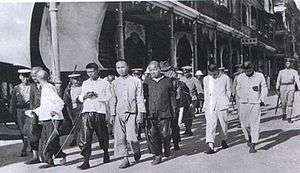
Before his ascension to political leadership in the Chinese Communist Party, Mao Zedong holistically embraced this Soviet ideological orthodoxy as the "correct" approach to the mobilization of ethnic minorities in China during the period of KMT administration. Corroborating the dominant Soviet thought in the Chinese Communist Party, Mao aligned himself with the Soviet strategy of ethnic liberation which saw the Leninist ethnic self-determination and confederate soviet socialist ethnic-autonomy as possible institutional models that China might follow if Communists might seize the power to create a multi-ethnic nation.[24] However, during the period of ideological dogmatism in the late 1920s and early 1930s, Mao grew increasingly skeptical of the Comintern leadership over the role of peasantry and rural-based nationalism in the Chinese Revolution. Especially after the Manchurian Incident in 1931 when Japan annexed the Chinese Northeast by establishing the puppet state of Manchukuo, Mao and his followers placed themselves in direct opposition to the leadership of the Comintern to articulate a vision of socialism that was grounded on the immediate desire to restore Chinese national sovereignty from foreign colonial powers, deviating from the internationalist strategy of the Comintern.[25]
Many of Mao's early writings reflect the growing schism in revolutionary theory. In February 1925, Mao wrote his first piece of ideological literature that directly dealt with the problem of ethnicity and national struggle in China. In his article named "the Analysis of Class Structure in Chinese Society (1925)," Mao identified two revolutionary groups in Chinese society, the peasants and the National Bourgeoisie, as potential allies of the Chinese proletariat revolution.[26] According to Mao, peasants are the most loyal and easily mobilized subjects of the Chinese revolutionary cause despite their obsession of commodity-exchange and land due to entrenched semi-feudal, petty-bourgeois mentality. On the other hand, National bourgeoisies are only temporary allies of the proletariat because their major interests are capital accumulation, which makes them dedicated to the preservation of national sovereignty and ethnic autonomy but not to the ultimate goal of socialist construction. These embryonic ideas of showed that Mao had already tried to fuse the notion of national and ethnic struggle with the theory of class struggle during the time of Soviet theoretical dominance.
Ideological consolidation: 1934–1937
The second phase of theoretical development (October 1934 – July 1937) overlapped with the period of Long March, when ideological hostilities toward KMT's political theory of sovereignty coincided with the gradual accession of Maoist leadership within the Chinese Party.[27] During this period of civil warfare, Mao's nascent political power cemented the dominance of his theory within the party leadership, which maintained that the project of restoring national sovereignty must take precedence before a nationwide campaign of class struggle.

When Mao ascended to party leadership in the CCP after the 1935 Zunyi Conference during the Long March, existing ideological schisms between Soviet and Chinese strategical approaches of the "National Question" and the "Ethnic Question" in China widened. One of the major disagreements was the role of ethnic minorities in Chinese revolution, which quickly expanded into a political debate about ethnic sovereignty and human agency. The original Leninist principle of ethnic liberation argued for a linear political strategy of liberation in which enlightened proletariats bind their revolutionary forces with ethnic minorities against capitalists, while assuming the responsibility to ideologically "uplift" and transform minorities into able proletariat fighters. Heralded by the pro-Comintern leaders of the CCP, this theory was the ideological cornerstone that buttressed CCP conceptions of statehood like national self-determination (Chinese: 民族自决; Pinyin: Minzu Zijue) and federated republic (Chinese: 联邦共和; pinyin: Lianbang Gonghe).[28] However, Mao disagreed with the Leninist model for two reasons: 1. The model of ethnic self-determination was inadequate for maintaining national unity; 2. The notion of ethnic "uplift" presupposes the passivity of ethnic minorities. For Mao, the ineffectuality of self-determination as a political model was self-explanatory, since this is the exact rhetoric which the Japanese Empire used to create the puppet state of Manchukuo. Shown in the example of Manchukuo, the failure of China to maintain its territorial sovereignty in the Northeast was primarily due to Japan's appeal to ethnic minority (in this case, the Manchu ethnicity that was the ruling aristocrats of the former Qing dynasty) desires for self-determination. Thus, to prevent further national disunity in China as a result of capitalist imperialists using ethno-cultural difference to "divide-and-rule" the proletariat population, Mao argued for a stronger form of ethnic sovereignty with limited ethnic autonomy.
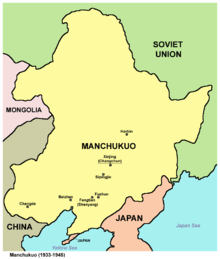
With regards to Mao's second disagreement with the Leninist principle, Mao argued for an active mobilization of ethnic minorities for the revolutionary war effort. As a remedy to Leninism's subjugation of minority agency, Mao replaced Lenin's overtly condescending phrase "small and weak ethnic groups" (Chinese: 弱小民族; Pinyin: ruoxiao minzu) with a more innocuous and ambiguous term "minority nationals" (Chinese: 少数民族; Pinyin: shaoshu minzu).[29] However, despite the fact that Mao refused to call ethnic minorities "inferior populations," he recognized that some of their conditions of socioeconomic production were more primitive than that of the Han-Chinese majority. As a result, Mao argued that the active mobilization of ethnic minorities must involve the simultaneous transformation of ethnic minority economic landscapes and the cultivation of class consciousness, which departed from the classical Marxist ideal of economic determinism ("base determines superstructure"). This notion of active transformation was predicated on the assumption that ethnic minorities inhabit in a more "backwards" (but not inferior) space of production.
In addition to the divergence from the Leninist principle of ethnic self-determination, Mao fervently rejected the KMT's theoretical conception of Chinese ethnic sovereignty. Here, the major disagreement came from Mao's idea that the "Chinese People" (Chinese: 中华民族; Pinyin: Zhonghua Minzu) was unified by ideology and cultural affinity, which contrasted with the KMT's narrative of a homogenous Chinese race tied by blood. In his writings, Mao dismissed the theory of Consanguineous Descent and Ethnic Sovereignty by the dominant KMT regime. These dominant theories included the Three People's Ideology (Chinese: 三民主义; Pinyin: Sanmin Zhuyi) by Sun Yat-sen and the racial ideology of Generalissimo Chiang Kai-shek. Sun Yat-sen's political ideal espoused the restoration of Han-Chinese dominance in China, which directly spoke to popular anti-Manchurian sentiments during the late Qing Dynasty. Chiang Kai-shek went one step further by asserting that China is a racially and ethnically homogenous nation, with Han-Chinese being the ancestral inhabitant of China and all other ethnic minorities being sub-varieties of the Han.[30] Mao critically rejected Chiang's theory and labelled him a "fascist" and "Han Chauvinist" for refusing to acknowledge the ethnic differences between Han-Chinese and other minorities.[31] Mao's theory was also heralded by one of the key architects of the party ideology of Maoist thought, Li Weihan, who pointed out the hypocrisy of Chaing's promise of "ethnic equality" in the KMT's national congress with regards to the ethnic education policies of the Hui Muslim population in Northwestern China. Like Mao, Li argued that the Hui Muslim population were not descendants of the Han people. Thus, the "correct" way to deal with their ethnic difference was not to impose traditional Han culture onto their ways of living, but to enforce ideological education in order to transform their belief from the Islamic religion to the "scientific truth of Marxism-Leninism." [32] This phase of theoretical development marks Mao's practical attempts to reconcile the internationalist rhetoric of Marxism-Leninism with the CCP's desire to construct a multi-ethnic nation-state.
Wartime nationalism: 1937–1949

The third phase was the "New Democratic revolutionary phase" (July 1937 – October 1949).[33] This phase of theoretical development is marked by the consolidation of Mao's political theory as the party orthodoxy during the war against Japanese Invasion (also called the Second Sino-Japanese War) from 1931–1945 and the subsequent war against the nationalists in the Chinese Civil War. During this period, Mao's political theory on ethnic sovereignty radically departed from the earlier Leninist approach that addressed the primacy of ethnic self-determination within the framework of Soviet Socialist Confederation.[34] Moreover, Mao dissented from Stalin's approach to the "National Question" which emphasized the creation of a Russia-centric Soviet Union ("Socialism in one country").[35] On April 13, 1941, the Soviet Union signed the Soviet–Japanese Neutrality Pact (Japanese: 日ソ中立条約 Romaji: Nisso Chūritsu Jōyaku), also known as the Japanese–Soviet Non-aggression Pact (Japanese: 日ソ不可侵条約 Romaji: Nisso Fukashin Jōyaku) with Japan two years after the brief Soviet–Japanese Border War (1939) As a retaliative reaction against USSR's non-aggression treaty with the Japanese Empire and Stalin's diplomatic recognition of Chiang Kai-shek as the head of China, Mao abandoned the USSR model of ethnic self-determination for the establishment of a unitary Chinese nation that would grant ethnic minorities partial ethnic autonomy under the Han-Chinese dominated CCP.[36]
According to historian James Leibold, Mao's new ethnic-autonomy theory necessitated the construction of a new cultural narrative of what "China" consists of demographically, geo-politically, and ethnographically.[37] Mao's search for a nativist unity of the Chinese nation led to the theorization of a transitional phase of revolution that is absent in any other Marxist works outside of China. In Mao's theory of history, the stage of "New Democracy" is a transitional phase of interclass and interethnic unity before the seizure of state power by the Chinese Communist Party. In terms of the political ideal of "national struggle" and the theory of ethnic relationships, Mao proposed the construction of Ethnic Self-Autonomous prefectures under CCP leadership, deviating from the CCP's early conception of a loose multi-ethnic confederation as well as the so-called "fascist" conception of Han-centric homogeneous nationhood by the KMT.[38]
The CCP's theoretical departure from the USSR was accompanied by a series of institutional transformations. One of which was the establishment of a distinctively Chinese bureaucratic agency named the United Front Work Department (UFWD) (Chinese: 中共中央统战部), dedicated to the regulation of ethnic relations and the preservation of national sovereignty under CCP leadership. The UFWD was created in Yan'an in 1942 during the height of the Second-Sino Japanese War. Although the UFWD was originally designed exclusively to deal with ethnic problems and contrive strategies to mobilize non-party local elites for the war against Japanese invasion, the UFWD shifted its strategic focus to the antagonization of KMT and the mobilization of ethnic minorities for national unification after the defeat of Japanese empire in 1945. Until 1949, the UFWD dealt exclusively with the question of National Struggle in China, with its 9th Department and 10th Department specifically devoted to the regulation of wartime Sino-Tibetan and Sino-Uighur relationships. In 1942, Li Weihan, the head of the UFWD, issued a strategic report to the CCP's Yan'an headquarters. In a report titled "Research on the Ethnic Question (1942)" (Chinese: 民族问题研究; Pinyin: Minzu wenti yanjiu) Li asserted that it was the responsibility of the "modern" Han majority, as China's ruling "Minzu" (ethnic group), to guide the Mongol, Hui, Tibetan, and other "backward minzus" toward their collective liberation and to foster the right environment in which "natural assimilation" (Chinese: 自然同化) could forge a new, more evolutionarily robust national people. This argument was predicated on the assumption that ethnic minorities could skip stages of economic development and become actively transformed into modern proletariats by having their economic terrains and productive forces transformed by the CCP leadership.[39] Li Weihan's narrative corroborated Mao's innovative approach to the "National Question," which expanded the narrow focus on "national liberation" in European and Soviet Marxism to embrace issues as ethnic development, state building, cultural identity, and national sovereignty in China.[40]
Practical confrontations: 1949–1965
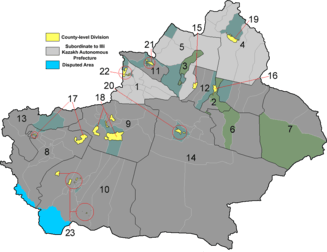
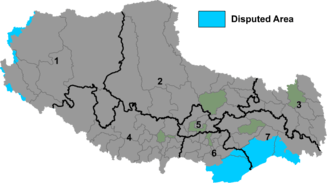
The fourth phase was the "Party Orthodoxy Phase" (October 1949 – May 1965), which was a period of ideological radicalization after the Chinese communists had seized state power in 1949.[41] This period of Maoist theoretical development is marked by the problems that stemmed from the CCP's practical confrontations with the reclamation of Manchuria, Xinjiang, and Tibet. Although Mao's political theory with regards to the regulation of ethnic minorities remained static during this time, this period is characterized by a series of political flip-flops, accomplishments, as well as disasters like the Hundred Flowers Campaign, the land reforms, the collectivization of agriculture, the Great Leap Forward, and the Great Famine.
The most salient ideological crisis during this period was the inconsistency between the theory and praxis of the CCP with regards to local bureaucratic administration, ethnic education, and cultural preservation.[42] Specifically, these problems entailed the paradoxical treatment of ethnic Tibetans, Uyghurs and Hui Muslim people by the Chinese Communist Party. On the one hand, the CCP promised ethnic equality by allowing limited degrees of cultural autonomy for minorities. On the other hand, the CCP imposed ideological education in ethnic schools and discouraged minorities from observing their cultural religious traditions because they have contradicted with the CCP's conception of Socialist Modernity. The theoretical remedy by Mao was to establish a unifying principle of "continuous National Struggle" that was unilaterally applied to each jurisdictional territories of ethnic autonomy. As a modification of Mao's earlier "National Struggle" theory, this theory argues that the quest for national struggle continues after the establishment of the People's Republic of China in 1949. This is because Mao reasoned that there was an unequal development of economic modes of production, social relations of production, and class consciousness between the ethnic minority hinterlands and the Han-majority urban areas in China. For example, in the Conference of the Central Committee in 1953, Mao stated that "some ethnic groups in Yunnan region continue to practice tribalism and live in primitive economic conditions of production."[43] Mao's solution to this problem was the criminalization of the practice of ethnic religions, accompanied by a series of land redistribution campaigns and technological experiments directed by sent-down cadres of the Constructions Corps.
During the prelude to the Cultural Revolution from 1966–1976, the difficulties of maintaining China's ethnic sovereignty also intersected with the problem of what Mao called the "Restoration of Capitalism."[44] Mao's unique view of historical materialism rendered his conclusion that seizure of state power and means of production by the Communists was not the end goal, but the beginning of socialist construction. Having based his revolution on the peasantry — the petty bourgeoisie of the countryside according to Lenin — Mao reasoned that the only way for the nation to secure its path towards Socialist Construction was to usher a perpetual campaign of national, ethnic, and class struggle even after the Communists have nationalized private capital and controlled the state apparatus.[45] Throughout the years of political radicalization, the Maoist theory of "national struggle" gradually diverged from the Soviet theory of revolution, which was guided by the Leninist principle of national self-determination within the USSR and Leon Trotsky's internationalist approach.[46] Although Mao initially followed Stalin's strategy towards the "National Question," Mao eventually discarded that idea when he faced a different demographic geography of ethnic identities in China's vast multi-ethnic terrain. In practice, Chinese communists under Mao's leadership approached the question of Xinjiang Insurrection, Tibetan Independence, and Hui Muslim dissent as problems that challenged the Chinese national sovereignty after the establishment of the PRC regime in 1949. The theoretical solution by Mao's party state was to reduce all of problems arising from the state's regulation of ethnocultural difference into an unequal distribution of the forces and relations of production.
Exporting revolution: 1966–1976
Impact
The international reception of Mao's theory of "national struggle" ranges from total rejection to critical appreciation. In the United States, rightist theorists have criticized Mao's theory of "national struggle" as the classical demonstration of hypocrisy within the socialist rhetoric of liberation. Other leftist scholars saw Mao's political theory as a capricious desire to subordinate Marx's dialectical historicism in the favor of China's particular realities in justification of Mao's political power. During the Cold War, the Maoist theory of "national liberation" was heralded by some French Marxists and Pan-Africanists as genuine political guidelines that could possibly provide a solution for self-sufficient development in third world economies if properly applied. After the death of Mao and the conclusion of the Cultural Revolution in 1976, public perception of Mao's political theory started turn negative globally. However, the contention over Maoism's contributions still exists today, as some scholars maintain that Mao's theory was actually rooted in Marx's dynamic notion of dialectical materialism, rather than the dogmatic application of Soviet stagiest theories of economic determinism.
Three Worlds Theory
References
- Mao, Zedong. "The Racial Question is a Class Question (1963)". Marxists.org. Marxist Internet Archive. Retrieved 19 November 2017.
- Leibold, James (2007). Reconfiguring Chinese Nationalism: How the Qing Frontier and its Indigenes Became Chinese. New York: Palgrave Macmillan. pp. 81–109. ISBN 978-1403974792.
- Mao, Zedong. "On New Democracy (1940)". Marxists.org. Marxist Internet Archive. Retrieved 19 November 2017.
- Mao, Zedong. "On New Democracy (1940)". Marxists.org. Marxist Internet Archive. Retrieved 19 November 2017.
- Chen, Guoxin. "毛泽东民族理论是马列主义民族理论在中国的实践和发展". ccln.gov.cn. 学术探索. Retrieved 22 November 2017.
- Knight, Nick (2007). Rethinking Mao: Explorations in Mao Zedong's Thought. Plymouth: Lexington Books. pp. 197–215. ISBN 978-0739117071.
- Dirlik, Arif (2005). Marxism in the Chinese Revolution. Oxford: Rowman & Littlefield Publishers. pp. 75–100. ISBN 9780742530690.
- Leibold, James (2007). Reconfiguring Chinese Nationalism: How the Qing Frontier and its Indigenes Became Chinese. New York: Palgrave Macmillan. pp. 81–109. ISBN 978-1403974792.
- Löwy, Michael. "Marxists and the National Question". newleftreview.org. New Left Review. Retrieved 20 November 2017.
- Löwy, Michael. "Marxists and the National Question". newleftreview.org. New Left Review. Retrieved 20 November 2017.
- 列宁,1920,《民族和殖民地问题委员会的报告》
- 列宁,1922,《关于民族或“自治化”问题》
- 列宁,1914,《论民族自决权》
- 列宁,1914,《精致的民族主义对工人的腐蚀》
- Löwy, Michael. "Marxists and the National Question". newleftreview.org. New Left Review. Retrieved 20 November 2017.
- Trotsky, Leon. "Permanent Revolution and Results & Prospects" (PDF). marxists.org. Marxists Internet Archive. Retrieved 9 December 2017.
- Hoston, Germaine (1994). The state, identity, and the national question in China and Japan. Princeton, NJ: Princeton University Press. pp. 365–401.
- Knight, Nick (2005). Marxist Philosophy in China: From Qu Qiubai to Mao Zedong, 1923–1945. Dordrecht, The Netherlands: Springer. pp. 1–28. ISBN 1402038054.
- Yang, Haijiao. "毛泽东民族理论论纲:历史演进、思想体系和实践价值". cssn.cn. 中国社会科学网. Retrieved 19 November 2017.
- Yang, Haijiao. "毛泽东民族理论论纲:历史演进、思想体系和实践价值". cssn.cn. 中国社会科学网. Retrieved 19 November 2017.
- Hoston, Germaine (1994). The state, identity, and the national question in China and Japan. Princeton, NJ: Princeton University Press. pp. 362–363.
- Hoston, Germaine (1994). The state, identity, and the national question in China and Japan. Princeton, NJ: Princeton University Press. pp. 362–363.
- "中华苏维埃共和国宪法大纲 (1934)". cpc.people.com.cn. 中国共产党新闻. Retrieved 19 November 2017.
- Yang, Haijiao. "毛泽东民族理论论纲:历史演进、思想体系和实践价值". cssn.cn. 中国社会科学网. Retrieved 19 November 2017.
- Hoston, Germaine (1994). The state, identity, and the national question in China and Japan. Princeton, NJ: Princeton University Press. pp. 362–363.
- Mao, Zedong. "中国社会各阶级的分析 (1925)". Marxists.org. Marxist Internet Archive. Retrieved 19 November 2017.
- Yang, Haijiao. "毛泽东民族理论论纲:历史演进、思想体系和实践价值". cssn.cn. 中国社会科学网. Retrieved 19 November 2017.
- Leibold, James (2007). Reconfiguring Chinese Nationalism: How the Qing Frontier and its Indigenes Became Chinese. New York: Palgrave Macmillan. p. 101. ISBN 978-1403974792.
- Leibold, James (2007). Reconfiguring Chinese Nationalism: How the Qing Frontier and its Indigenes Became Chinese. New York: Palgrave Macmillan. pp. 100–102. ISBN 978-1403974792.
- Mullaney, Thomas S. (2011). Coming to Terms with the Nation: Ethnic Classification in Modern China. Berkeley: University of California Press. pp. 2–5. ISBN 9780520262782.
- 毛泽东选集:第三卷. 北京: 人民出版社. 1991.
- Yang, Haijiao. "毛泽东民族理论论纲:历史演进、思想体系和实践价值". cssn.cn. 中国社会科学网. Retrieved 19 November 2017.
- Yang, Haijiao. "毛泽东民族理论论纲:历史演进、思想体系和实践价值". cssn.cn. 中国社会科学网. Retrieved 19 November 2017.
- Leibold, James (2007). Reconfiguring Chinese Nationalism: How the Qing Frontier and its Indigenes Became Chinese. New York: Palgrave Macmillan. pp. 147–175. ISBN 978-1403974792.
- Leibold, James (2007). Reconfiguring Chinese Nationalism: How the Qing Frontier and its Indigenes Became Chinese. New York: Palgrave Macmillan. pp. 147–175. ISBN 978-1403974792.
- Leibold, James (2007). Reconfiguring Chinese Nationalism: How the Qing Frontier and its Indigenes Became Chinese. New York: Palgrave Macmillan. pp. 147–175. ISBN 978-1403974792.
- Leibold, James (2007). Reconfiguring Chinese Nationalism: How the Qing Frontier and its Indigenes Became Chinese. New York: Palgrave Macmillan. pp. 147–175. ISBN 978-1403974792.
- Leibold, James (2007). Reconfiguring Chinese Nationalism: How the Qing Frontier and its Indigenes Became Chinese. New York: Palgrave Macmillan. pp. 147–175. ISBN 978-1403974792.
- Leibold, James (2007). Reconfiguring Chinese Nationalism: How the Qing Frontier and its Indigenes Became Chinese. New York: Palgrave Macmillan. p. 107. ISBN 978-1403974792.
- Hoston, Germaine (1994). The state, identity, and the national question in China and Japan. Princeton, NJ: Princeton University Press. pp. 365–401.
- Yang, Haijiao. "毛泽东民族理论论纲:历史演进、思想体系和实践价值". cssn.cn. 中国社会科学网. Retrieved 19 November 2017.
- Leibold, James (2007). Reconfiguring Chinese Nationalism: How the Qing Frontier and its Indigenes Became Chinese. New York: Palgrave Macmillan. pp. 1–16. ISBN 978-1403974792.
- "关于过去几年内党在少数民族中进 行工作的主要经验总结 (1953)". cpc.people.com.cn. 中国共产党新闻. Retrieved 20 November 2017.
- Esherick, Joseph W. (1979). "On the "Restoration of Capitalism": Mao and Marxist Theory". Modern China. 5 (1): 41–78. doi:10.1177/009770047900500102.
- Esherick, Joseph W. (1979). "On the "Restoration of Capitalism": Mao and Marxist Theory". Modern China. 5 (1): 41–78. doi:10.1177/009770047900500102.
- Löwy, Michael. "Marxists and the National Question". newleftreview.org. New Left Review. Retrieved 20 November 2017.
Further reading
- Bernstein, Thomas and Li, Hua-yu (eds).China Learns from the Soviet Union, 1949–Present. Plymouth, UK: Lexington Books, 2010.
- Dirlik, Arif. Marxism in the Chinese Revolution. Lanham, MD: Rowman & Littlefield, 2005.
- Esherick, Joseph. "On the Restoration of Capitalism: Mao and Marxist Theory."Modern China Vol. 5, No. 1 (Jan., 1979), pp. 41–77.
- Hoston, Germaine. The State, Identity, and the National Question in China and Japan. Princeton, NJ: Princeton University Press, 1994.
- Karl, Rebecca E. Mao Zedong and China in the Twentieth Century World. Durham, NC: Duke University Press, 2010.
- Karl, Rebecca E. The Magic of Concepts: History and the Economic in Twentieth-Century China. Durham, NC: Duke University Press, 2017.
- Knight, Nick. Rethinking Mao: Explorations in Mao Zedong's Thought. Plymouth, UK: Lexington Books, 2007.
- Leibold, James. Reconfiguring Chinese Nationalism: How the Qing Frontier and its Indigenes Became Chinese. London, UK: Palgrave Macmillan, 2007.
- Lowe, Donald. The Function of "China" in Marx, Lenin, and Mao. Berkeley, CA: University of California Press, 1966.
- Löwy, Michael. "Marxists and the National Question." New Left Review Vol. 96, No. 1 (March–April., 1976).
- Meisner, Maurice. Mao's China and After: A History of the People's Republic. New York, NY: Free Press, 1986.
- Meisner, Maurice. Li Ta-chao and the Origins of Chinese Marxism. Original, 1966. ACLS Humanities E-Book (August 1, 2008).
- Mullaney, Thomas. Coming to Terms with the Nation: Ethnic Classification in Modern China. Berkeley, CA: University of California Press, 2010.


